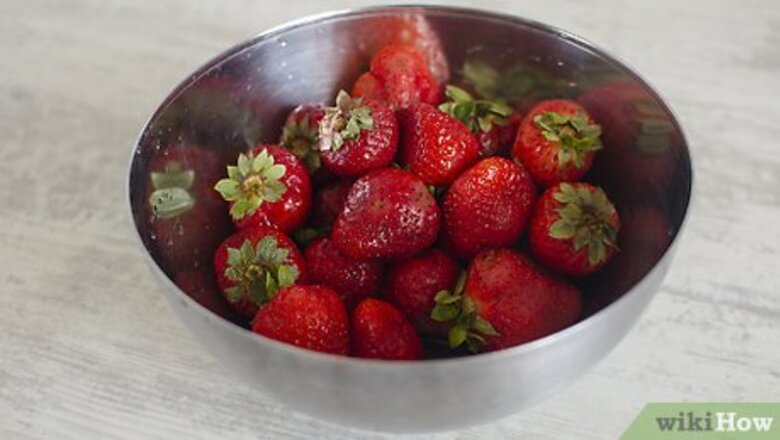
views
Freezing Plain Strawberries
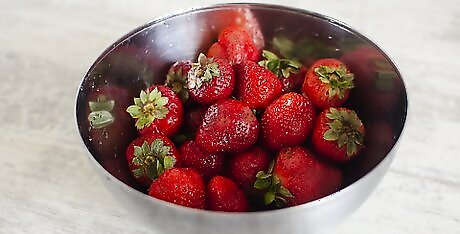
Wash the strawberries under cold running water. Before hulling or slicing your strawberries, put them in a colander and rinse them under cold running water to remove any trace amounts of pesticides, chemicals, or dirt. Make sure that the water is draining out the bottom of the colander and that the strawberries don’t soak for long, as this can cause them to start to lose their flavor. If you are using organic strawberries, you may want to make an organic fruit wash to ensure that the strawberries are very clean. After washing, you can left the strawberries air dry in the colander or pat them dry with a clean paper towel.
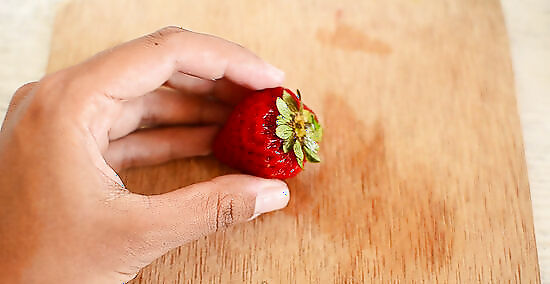
Hull the strawberries to remove the leafy stem. Using a small paring knife, cut a circle around the leafy stem at the top of one of the strawberries. Angle the knife in towards the middle as you cut. Then, either pull on the leaves with your fingers or put the knife under the leaves and push up to remove the hull. You can also use a straw to remove the hull. To do this, stick a straw through the small, pointed end of the strawberry. Push through the strawberry until the straw pushes the hull off the other side. Repeat this process until all the strawberries are hulled.
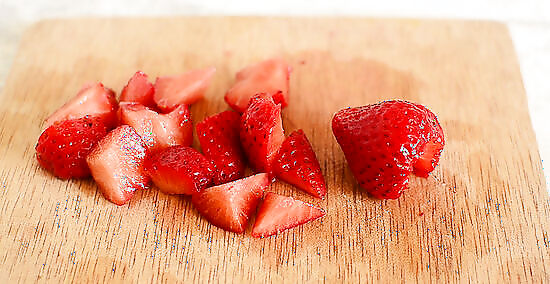
Cut into halves or quarters if you want smaller frozen strawberries. If you are planning to use your frozen strawberries for a recipe that calls for sliced strawberries, or if you prefer that the strawberries be pre-cut, use a sharp knife to slice the strawberries into your preferred size. If you want to freeze the strawberries whole, you can skip this step.
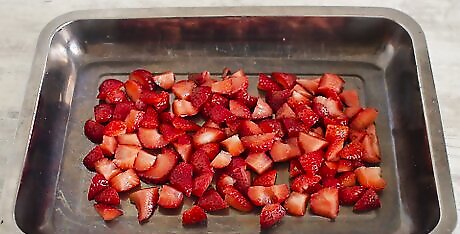
Spread the strawberries out on a baking sheet. After washing, hulling, and cutting the strawberries or leaving them whole, spread them out on a large baking sheet. If possible, spread them out so that none of the strawberries are touching each other. This will keep the strawberries from sticking together in one big clump.
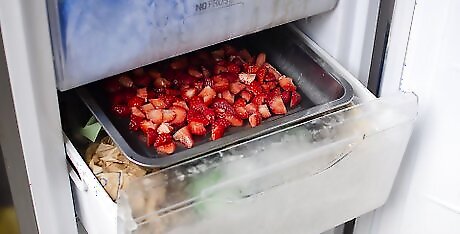
Place the baking sheet in the freezer for 1 to 4 hours. Try to place the baking sheet in the freezer so that it is level to keep the strawberries from sliding together. Leave the baking sheet with the strawberries in the freezer for 1 to 4 hours, or until all of the strawberries are completely frozen solid. To check if the strawberries are frozen solid, press down firmly on one of the strawberries with your finger. If the strawberry stays firm against the pressure, it is done freezing.
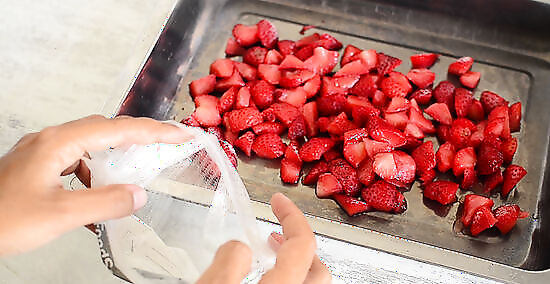
Transfer the frozen strawberries into plastic freezer bags. Once the strawberries on the baking sheet are completely frozen solid, remove the baking sheet from the freezer. Transfer the strawberries into plastic freezer bags quickly so that they don’t have time to start to melt. Seal the freezer bags and place them in the freezer to store for future use. Write the date on the freezer bags so you know how long the frozen strawberries will keep.
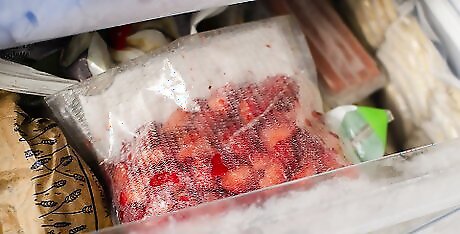
Store your frozen strawberries in the freezer for up to 6 months. Before using your frozen strawberries, check the date that you wrote on the freezer bags. After 6 months, your frozen strawberries should be discarded. Use your frozen strawberries within 6 months to make a strawberry smoothie or as a quick and easy topping for ice cream.
Storing Frozen Strawberries with Sugar
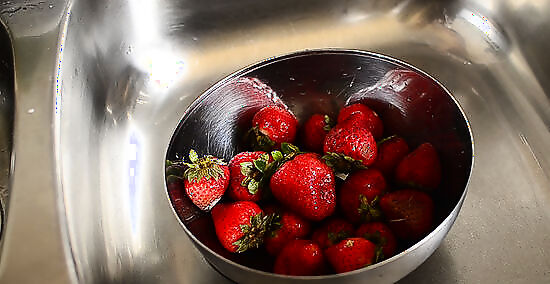
Wash the strawberries with cold water. Before hulling your strawberries, put them in a straining bowl and rinse them under cold running water to remove any trace amounts of pesticides, chemicals, or dirt. Make sure that the water is draining out the bottom of the strainer so that the strawberries don’t soak for long. If you are using organic strawberries, you may want to make an organic fruit wash to get your strawberries extra clean.
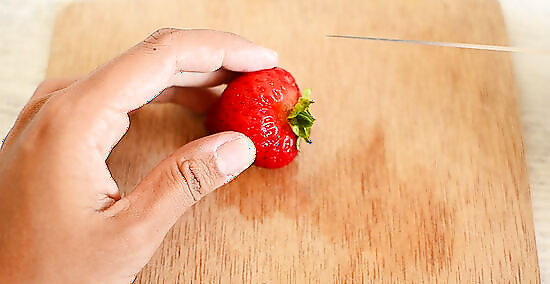
Use a knife or straw to hull the strawberries. To hull with a knife, cut a circle around the hull (the leafy stem at the top) of one of the strawberries with a small paring knife. Angle the knife in towards the middle as you cut, then pull on the leaves with your fingers to pull out the hull. To hull with a straw, stick the straw through the small, pointed end of the strawberry and push through the strawberry until the straw pushes the hull off the other side. Repeat this process with either a knife or straw until all the strawberries are hulled.
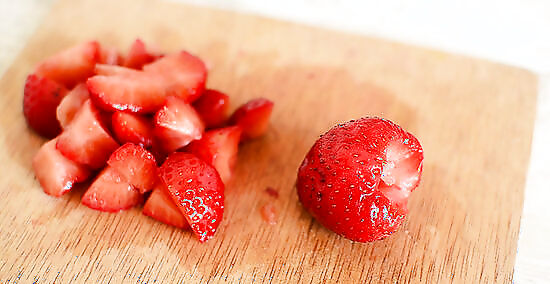
Slice or crush the strawberries in a bowl. Once the strawberries are washed and hulled, you can use a sharp knife to cut them into halves, quarters, or thin slices. If you want a more jam-like consistency, put the strawberries in a bowl and use a wooden spoon or potato masher to crush the strawberries up. You can also leave the strawberries whole, though they won’t soak up as much sugar as they will if they are sliced or crushed. You may want to crush the strawberries if you plan to freeze them to use later as a spread or cake filling.
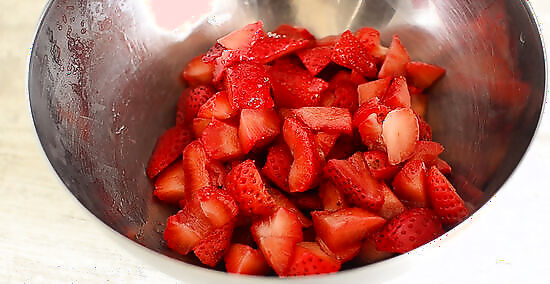
Sprinkle white granulated sugar on top of the strawberries. Using a measuring cup, scoop the strawberries into a large mixing bowl, counting the number of cups as you go. Then, sprinkle about ⁄2 cup (120 mL) of white granulated sugar for every 4 cups (950 mL) of strawberries. You can decrease or increase the amount of sugar a little depending on your taste. While using white sugar is more common, you can use brown sugar or a sugar substitute, such as Splenda or stevia, for this as well.
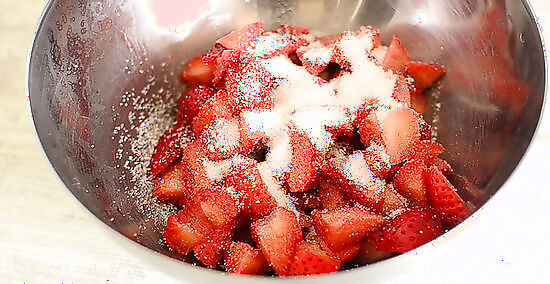
Mix for 1 to 2 minutes until the sugar is barely visible. Use a large spoon to stir the strawberries and sugar together. Continue to stir until the sugar completely coats the strawberries, about 1 or 2 minutes. As you stir and the sugar coats the strawberries, the strawberries will begin to absorb the sugar, making it only barely visible.
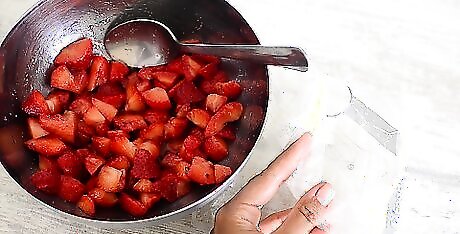
Transfer the sugar-coated strawberries into a freezer bag. After coating the strawberries in sugar, pour the strawberries slowly into a large freezer bag. If the bowl is too large to pour, you can use a large spoon to transfer the strawberries one scoop at a time. Once all the strawberries are in the bag, seal the bag tightly and place it in the freezer for future use. The sugar coating will help prevent the strawberries from freezing and clumping together, so you don’t need to worry about freezing them separately first. Write the date on the freezer bags before putting them in the freezer so you know how long your frozen sugar strawberries will keep.
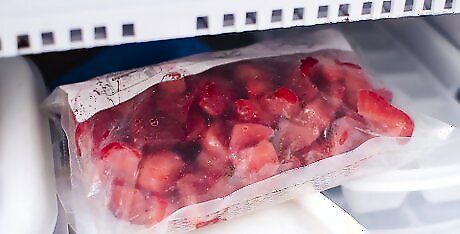
Store your frozen sugar strawberries in the freezer for up to 6 months. Before using your frozen sugar strawberries, check the date that you wrote on the freezer bags. After 6 months, the sugar strawberries should be discarded. When used within 6 months, strawberries frozen in sugar tend to work well when baking in a cake. Unlike strawberries frozen in simple syrup, sugar strawberries have less liquid and won’t make your cake batter runny.
Keeping Frozen Strawberries in Simple Syrup
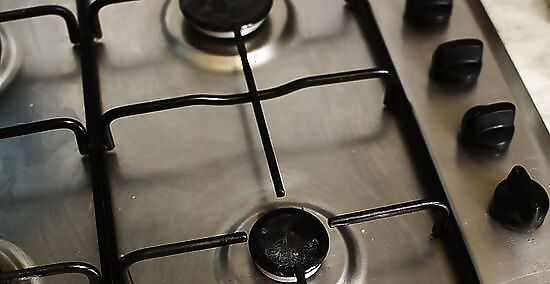
Make the simple syrup with sugar and water. To make an easy homemade simple syrup, mix equal parts water and white granulated sugar in a saucepan. Bring the mixture to a boil, then turn the heat down to a simmer. Let the mixture simmer for 3 to 5 minutes until the sugar is dissolved, stirring occasionally with a whisk or spoon. Then, remove the saucepan from heat to let the simple syrup cool to room temperature. To figure out how much simple syrup to make, measure the amount of strawberries. For every 2 cups (470 mL) of strawberries, you will need ⁄2 cup (120 mL) of simple syrup. Therefore, if you have 8 cups (1,900 mL) of strawberries, make 2 cups (470 mL) of simple syrup. If you make simple syrup ahead of time, you can keep it fresh in the refrigerator for several weeks.
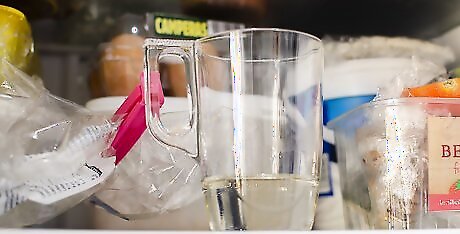
Chill the simple syrup in the refrigerator for 4 hours. Once the simple syrup has cooled to room temperature, transfer it into a glass jar or bottle. Place the jar or bottle in the refrigerator for about 4 hours, or until the syrup is completely chilled.
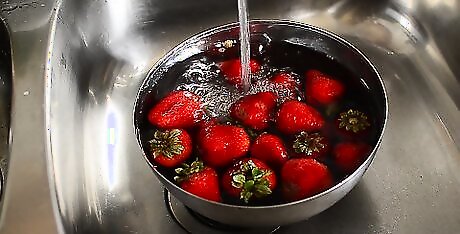
Wash the strawberries under cold running water. While the simple syrup is cooling in the refrigerator, wash the strawberries by putting them in a strainer and rinsing them under cold running water. Make sure that the water is draining out the bottom of the colander and that the strawberries don’t soak for long – this can make them start to lose their flavor. If you are using organic strawberries, you may want to make an organic fruit wash to ensure that the strawberries are very clean.
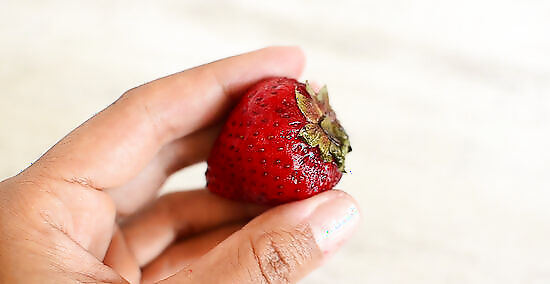
Use a knife or straw to hull the strawberries. To hull with a knife, cut a circle around the hull (the leafy stem at the top) of one of the strawberries with a small paring knife. Angle the knife in towards the middle as you cut, then pull on the leaves with your fingers to pull out the hull. To hull with a straw, stick the straw through the small, pointed end of the strawberry and push through the strawberry until the straw pushes the hull off the other side. Repeat this process with either a knife or straw until all the strawberries are hulled.
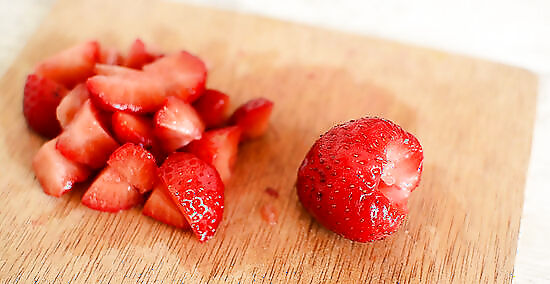
Slice or crush the strawberries (optional). Once the strawberries are washed and hulled, you can use a sharp knife to cut them into halves, quarters, or thin slices. If you want a more jam-like consistency, put the strawberries in a bowl and use a wooden spoon or potato masher to crush the strawberries up. If you want to leave the strawberries whole, you can skip this step. Crushing the strawberries in a bowl is a great option if you plan to use them as a mixer in a cocktail.

Place the strawberries in a freezer-safe container with a lid. Once the strawberries are sliced, crushed, or left whole, use a measuring cup to scoop them into a large freezer-safe container. If you do not have a large container or want to make several individual batches, you can separate the strawberries into several smaller containers. Count the number of cups that you put in each container.
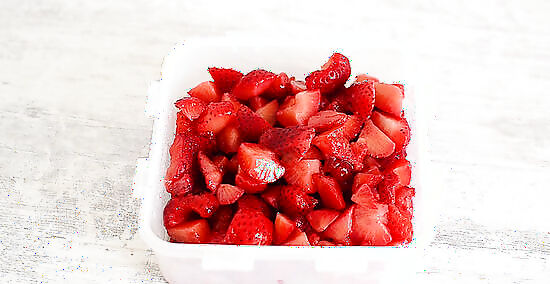
Pour the chilled simple syrup over the strawberries. Remove the simple syrup from the refrigerator. Then, using a measuring cup, pour ⁄2 cup (120 mL) of simple syrup for every 2 cups (470 mL) of strawberries until the container is full. The strawberries should be completely inundated in the syrup. If the strawberries are not all completely covered by the syrup, add more until all are submerged in the liquid.
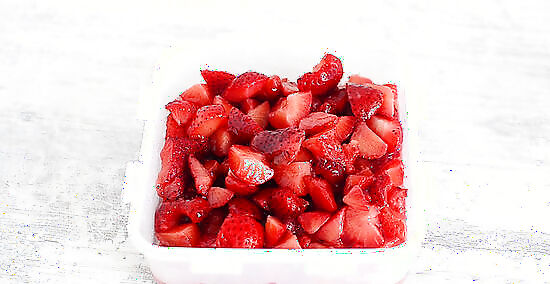
Add a flavor extract for a more interesting taste (optional). To add a subtle extra flavor to your strawberries, add about 1 teaspoon (4.9 mL) of an additional flavor extract, such as orange zest or vanilla, to every 2 cups (470 mL) of strawberries in simple syrup. The strawberries will absorb the extract as they freeze, giving them a more unique and interesting flavor later on. You can also add spices if you choose. Cinnamon and cardamom, for example, taste great on strawberries frozen in simple syrup.
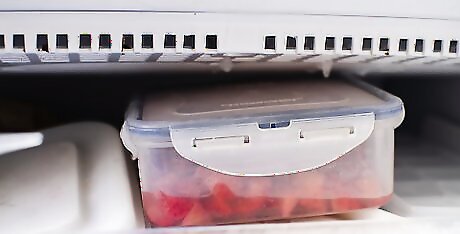
Store the strawberries in the freezer for up to 6 months. Once the containers are full and you’ve added any additional flavors, tightly seal the top(s) back on the container(s). Place the simple syrup strawberries in the freezer to freeze for future use. Storing them in sugary liquid helps the strawberries keep their color and shape while absorbing some of the sweetness from the simple syrup. When you decide to use the simple syrup frozen strawberries, thaw them on the counter at room temperature for about 4 hours.



















Comments
0 comment